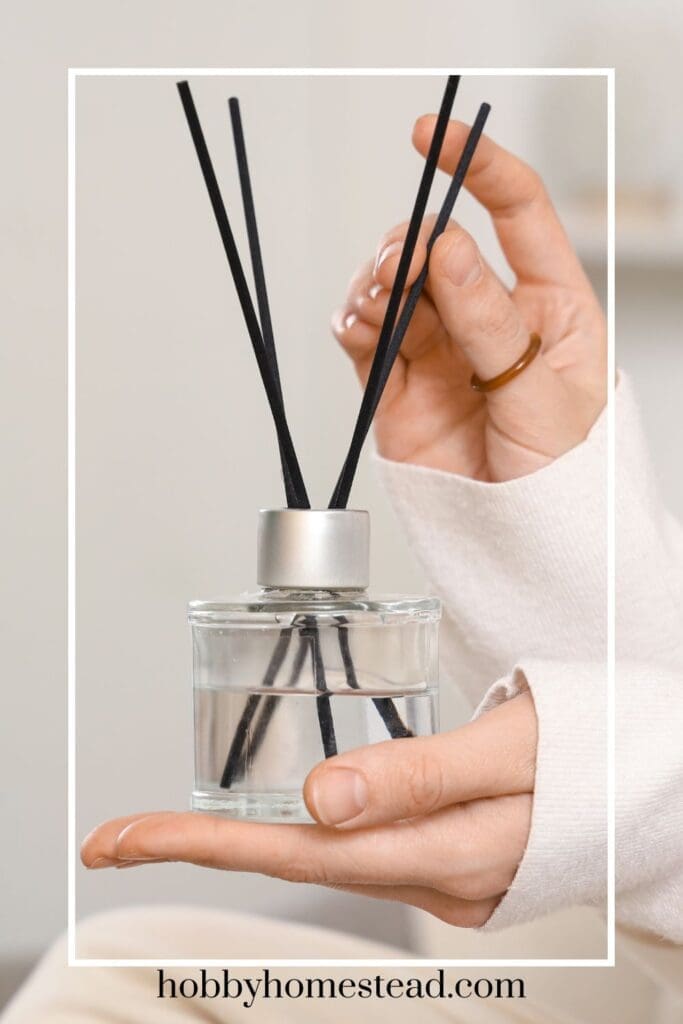Last updated on August 6th, 2025 at 11:08 pm
Learn how to make a reed diffuser and best essential oil refills. If you’ve ever walked into a room and been instantly soothed by a subtle, refreshing aroma, chances are you’ve experienced the calming effect of a reed diffuser.
In this guide, you’ll learn everything you need to know to create your own long-lasting, non-toxic home fragrance using natural ingredients. From choosing the right carrier oil, to blending your favorite essential oils for a consistent scent throw.
Make a Reed Diffuser
We’ll walk you through how to make a DIY reed diffuser that rivals any store-bought version. Whether you’re looking for a floral scent, earthy scent, or something with refreshing citrus oils. Making your own reed diffuser oil is easier than you may think. And better for your home and your wallet.

There’s nothing quite like walking into your living space and being greeted by a gentle, refreshing scent. Reed diffusers are a natural and beautiful way to keep your home smelling wonderful without flames or sprays.
But store-bought refills can get expensive—not to mention full of synthetic additives. The good news? You can make your own reed diffuser oil refills easily using a DIY reed diffuser recipe with natural carrier oils and your favorite drops of essential oil or fragrance oils.
Let’s dive into how to create the perfect reed diffuser oil refill, using ingredients that are gentle on human skin, great for sensitive skin, and provide a consistent scent throw.
What is a Reed Diffuser?
A reed diffuser is a simple and elegant way to naturally scent your living space without electricity, flames, or sprays. It typically consists of a glass bottle or jar with a narrow opening, filled with a mixture of carrier oil and essential oils or fragrance oils.
Into this mixture, you place reed diffuser sticks. Usually rattan reeds, which are specially designed to draw liquid up through their tiny channels and release the scent into the air.
DIY reed diffusers are a great way to customize the fragrance of your home using natural ingredients. Especially if you’re sensitive to commercial air fresheners or looking for a low-tox living solution.
How Do Reed Diffusers Work?
Reed diffusers work through a simple process known as capillary action. The reed sticks, whether you’re using rattan reeds or even bamboo skewers in a pinch, absorb the scented diffuser oils from the container and slowly release the aroma into the air.
The reeds’ hollow channels absorb the reed diffuser oil and slowly diffuse it throughout the room. To make this work well, you need a carrier oil with a low viscosity and thin consistency to flow easily through the reeds.
Here’s how it happens:
- The carrier oil (also known as the base oil) thins out the essential oil and helps it travel up the reeds.
- As the liquid reaches the top of the sticks, the fragrance evaporates into the room.
- This process provides a consistent scent throw that lasts for weeks, depending on the formula, room size, and airflow.
Want a stronger scent? Just flip the reed diffuser sticks every few days. The more sticks you use, the more fragrance is released—though using too many may use up your oils faster.
Why Make Your Own Reed Diffuser Refill?
- Custom scents using a wide range of essential oils
- Avoid artificial ingredients and preservatives
- Save money
- Reduce waste
- Control the strength and style of scent in your home
What are Carrier Oils?
Carrier oils are the unscented or lightly scented base oils used to dilute essential oils and help “carry” them through the diffuser reeds. Without a carrier oil, essential oils would be too strong and evaporate too quickly. The role of carrier oils in a reed diffuser is crucial for long-lasting scent, even absorption, and proper diffusion.
The best carrier oils for reed diffusers are those with:
- A low viscosity or thin consistency
- A light scent or neutral aroma
- A long shelf life
- Good absorption and flow properties
Some of the most popular carrier oils for reed diffuser refills include:
- Sweet almond oil. A good choice with a light consistency.
- Grapeseed oil. Extracted from grape seeds, with a fast absorption rate.
- Fractioned coconut oil. Stays liquid and odorless, a popular choice.
- Safflower oil. A great alternative with a non-greasy oil feel.
- Jojoba oil. Slightly thicker but very stable, excellent for sensitive skin.
- Apricot kernel oil, rosehip oil, and even argan oil (the “liquid gold of Morocco”) are also used by some for their unique properties
Be careful to avoid a wrong base oil like olive oil or baby oil, which can be too thick or have a heavy scent that clashes with your top notes and middle notes.
When you select the best oil for your reed diffuser recipe, you’re ensuring not just a better-smelling home, but a longer-lasting and more effective product.
Se me making my reed diffuser refill on our YouTube Channel.
The Role of Carrier Oils in Diffuser Oils
The carrier oil is the unsung hero in any reed diffuser recipe. It dilutes the essential oil and ensures a consistent scent throw. The best base oil should be:
- Light and non-greasy
- Long-lasting (with a long shelf life)
- Mild in scent (so it doesn’t compete with your aromatic oils)
- Easily absorbed by rattan reeds or bamboo skewers
Let’s look at a list of the best carrier oils you can use.
How To Make a Reed Diffuser and Best Essential Oil Refills
As an Amazon Associate I earn from qualifying purchases.
Equipment
Materials
- ¼ cup carrier oil
- 20-30 drops essential oil or fragrance oils
Instructions
How To Make Reed Diffuser Essential Oil Refills
Step 1: Choose the Right Carrier Oil
- Pick a popular carrier oil like grapeseed oil or sweet almond oil. These have a thin consistency and offer a long shelf life, making them a perfect choice for diy reed diffuser blends.¼ cup carrier oil
Step 2: Add Your Essential or Fragrance Oils
- Use around 20–30 drops of essential oil. For a balanced blend:20-30 drops essential oil
- Top notes. citrus oils like lemon or bergamot (bright and sharp)
- Middle notes. lavender or geranium (floral scents)
- Base notes. earthy scents like black pepper or patchouli
Step 3: Mix and Pour
- In a small bowl or jar, mix your oils at room temperature. Use a funnel to pour the liquid into your diffuser container.
Step 4: Insert the Reeds
- Place 5–7 diffuser reeds or reed diffuser sticks into the bottle. After an hour, flip the reeds to begin the diffusion process.
Notes
Custom Scent Ideas for Homemade Reed Diffusers
- Floral Blend. Lavender, geranium, and bergamot with apricot kernel oil
- Citrus Refresh. Lemon, grapefruit, and rosemary with fractioned coconut oil
- Earthy Calm. Patchouli, black pepper, and rosehip oil
- Clean Home Scent. Tea tree, peppermint, and eucalyptus in grapeseed oil
Best Carrier Oils for Reed Diffuser Refills
Choosing the right carrier oil is essential for making an effective and long-lasting reed diffuser oil.
Not all oils are created equal—some are too thick, some go rancid quickly, and others have overpowering aromas that can clash with your chosen scent.
Below are some of the best carrier oils to consider for your DIY reed diffuser, along with notes on why they’re a good choice or why they may not be the best base oil depending on your needs.
1. Sweet Almond Oil
A popular carrier oil with a light consistency and barely-there scent, making it ideal for diffuser oils. It’s a natural source of vitamins, especially Vitamin E, and works well in room temperature settings. Its mild profile won’t compete with your aromatic oils, making it a great choice for everyday use.
2. Fractioned Coconut Oil
Unlike regular coconut oil, which solidifies at cooler temps, fractioned coconut oil stays liquid and has a thin consistency. It’s colorless, odorless, and has a long shelf life, making it a perfect choice if you’re looking for a neutral carrier. Plus, it’s easily absorbed by rattan reeds or bamboo skewers.
3. Grapeseed Oil
Extracted from grape seeds, this oil is known for its low viscosity and high absorption rate. It’s also rich in fatty acids and Vitamin E, making it both nourishing and efficient in diffusing scent. Its clean, non-greasy oil profile makes it an excellent carrier oil for homemade diffusers.
4. Safflower Oil
Safflower is a great alternative that’s often overlooked. With a light consistency and neutral scent, it allows your top notes, middle notes, and base notes to shine. It works particularly well for those who prefer refreshing scents or more subtle fragrance combinations.

5. Jojoba Oil
Although technically a wax ester, jojoba oil behaves like a carrier oil and is prized for its long shelf life. It mimics the natural oils of human skin, making it ideal for those with sensitive skin. It has a slightly thicker consistency, so it’s better for smaller diffusers or where slower scent release is desired.
6. Apricot Kernel Oil
Another good carrier oil, apricot kernel oil has a light texture and soft nutty aroma. It’s often used in blends with floral scents and citrus oils, and because it absorbs quickly, it’s a popular choice among natural fragrance crafters.
7. Argan Oil
Often called the “liquid gold of Morocco,” argan oil is packed with Vitamin E and oleic acid, making it luxurious but heavier than other oils. It’s extracted from the kernels of the argan tree and has a distinctive nutty aroma. While it’s not a traditional diffuser oil, it can work well in small amounts if blended with a thinner oil like safflower or grapeseed oil.
8. Rosehip Oil
Known for its high content of fatty acids and oleic acid, rosehip oil is better suited for earthy scents and heavier blends. It has a thicker consistency, so use it sparingly or blend it with a light carrier oil to avoid clogging your reed diffuser sticks.
9. Olive Oil
While it’s easy to find, olive oil has a strong scent and thicker consistency, making it a wrong carrier oil choice for reed diffusers unless heavily diluted. It tends to overpower more delicate essential oils and slows down the diffusion process.
Carrier Oils to Avoid
Some oils may seem convenient but aren’t ideal for diffuser use:
- Baby oil. Contains petroleum-based ingredients and artificial scents.
- Vegetable oil. Often has a strong odor and inconsistent quality.
- Mineral oil. Doesn’t absorb well and doesn’t support scent release.
Final Thoughts on Carrier Oils
The best oil for your reed diffuser depends on your climate, desired scent strength, and reed type. Lighter oils like grapeseed, safflower, and fractioned coconut oil are universally loved for their liquid consistency, long shelf life, and compatibility with reed diffuser sticks.
Avoid oils with a thicker consistency or strong smell unless you blend them thoughtfully with lighter options.
Top tip. Avoid baby oil or heavily perfumed oils. Using the wrong carrier oil or wrong base oil can clog your reeds and hinder the scent throw.
Do reed diffusers work?
Yes! When made with the right carrier oil and diffuser oils, they provide a consistent scent throw for weeks.
Can I reuse my reeds?
It’s best to replace reed diffuser sticks when refilling to avoid clogged channels and weak diffusion.
Where should I place my diffuser?
Avoid direct sunlight or heat. A dark place helps preserve your diffuser oils.
Can I use olive oil or baby oil?
I would not recommend them. Olive oil has a thicker consistency and isn’t a good carrier oil for reeds. Baby oil is petroleum-based and not a natural carrier oil—avoid it.

Tips for Using Reed Diffusers Effectively
Reed diffusers are a low-maintenance, flame-free way to keep your living space smelling fresh all day long. But to get the most out of your DIY reed diffuser, it helps to know a few tricks. From finding the ideal spot to choosing the best reed diffuser sticks, these tips will help you achieve a consistent scent throw and extend the life of your homemade diffuser oil.
Choosing the Right Location
Where you place your reed diffuser can make a big difference. For the best results, set your diffuser in a room temperature area with some airflow—like a hallway, bathroom, or bedside table. Avoid placing it near open windows or vents where the scent might dissipate too quickly.
A narrow opening in your diffuser bottle helps slow evaporation and preserves your diffuser oils longer. Choose a central location in the room to allow the fragrance to distribute evenly. Avoid placing your diffuser directly on delicate wood surfaces, as carrier oils can damage finishes over time.
Enhancing Scent Throw
Want to boost your diffuser’s performance? Here are a few top tips:
- Use rattan reeds with visible open channels—they’re the best choice for strong capillary action.
- Flip the reed sticks every few days for a fresh burst of fragrance.
- Use 5–10 drops of essential oil per ounce of carrier oil for optimal strength.
- The thinner the carrier oil’s consistency, the better the absorption—grapeseed oil and sweet almond oil are excellent choices with low viscosity.
Maintenance
Maintaining your reed diffuser is key to keeping your home smell fresh:
- Flip the diffuser reeds weekly or whenever the scent fades.
- Replace the reeds every 1–2 months—old reeds can become saturated and stop working.
- Refill with fresh oil once the bottle is half-empty to prevent drying out.
If you’re switching essential oil blends, be sure to clean the bottle first to avoid mixing aromatic oils and muddying the scent.
An Alternative to Rattan Reeds
If you don’t have rattan reeds on hand, bamboo skewers can work in a pinch—but they’re less effective due to their thicker consistency and lack of open channels. Still, they can be a great alternative for a temporary solution or in a decorative pinch.
Keep in mind that reed diffuser sticks should have a thin consistency to wick oil effectively. That’s why rattan reeds remain the best base for maximum scent throw.
How Do I Clean Reed Diffuser Bottles After Use?
To clean your diffuser bottle:
- Discard any leftover diffuser oil.
- Rinse the bottle with warm water and a little form of alcohol like rubbing alcohol or vodka to break down oil residue.
- Let the bottle dry completely before refilling.
Always clean thoroughly between scent changes—especially when moving from floral scents to earthy scents or citrus oils. This avoids mixing conflicting notes and ensures your next reed diffuser recipe is crisp and clean.
Making your own reed diffuser essential oil refills is a great way to keep your home smelling beautiful while avoiding synthetic ingredients. With a little bit of the best oil, your favorite aromatic oils, and some simple supplies, you can enjoy a non-toxic, customizable scent solution.




This worked exactly as written, thanks!